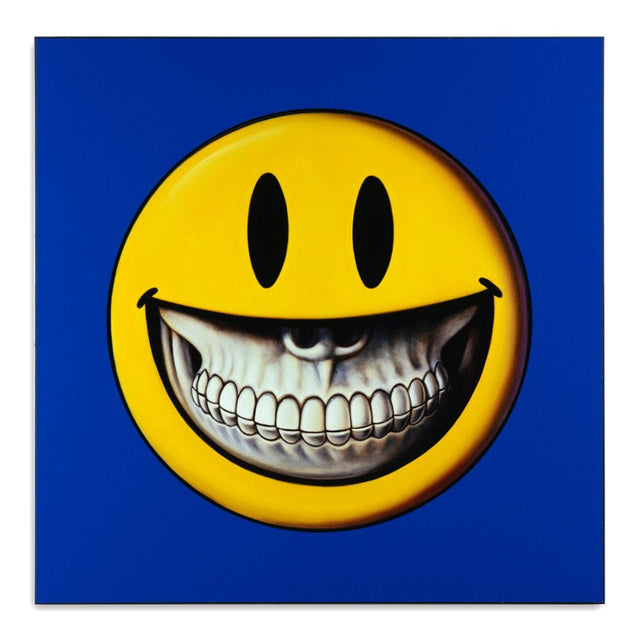
Smiley Face
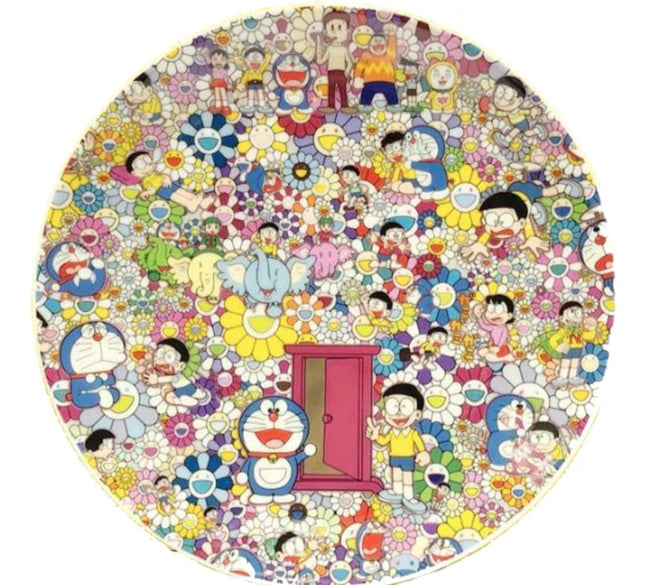
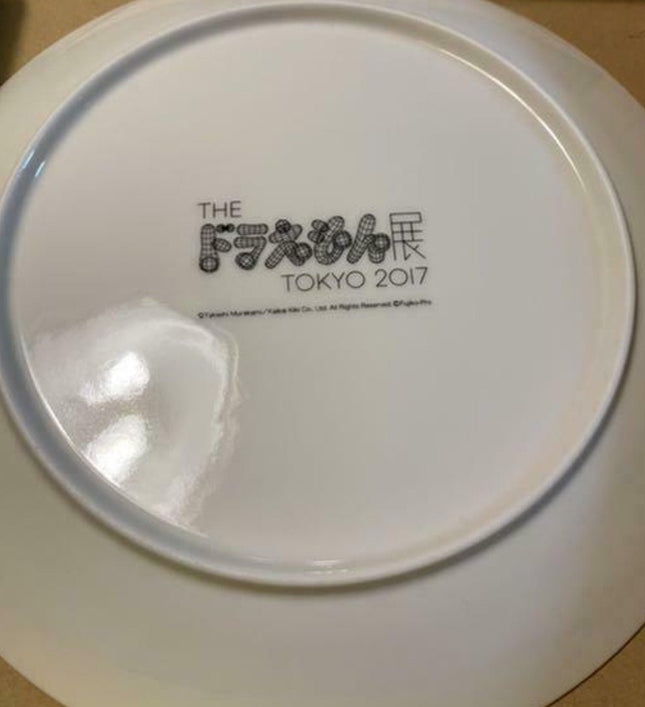
Takashi Murakami TM/KK Doraemon Exhibition Tokyo Archival Pigment Plate by Takashi Murakami TM/KK
Doraemon Exhibition Tokyo Plate Limited Edition Archival Pigment Print Art on Ceramic Plate Artwork by Famous Artist Takashi Murakami TM/KK. 2017 Limited Edition Size 9" Collectible Art Plate Takashi Murakami's Intersection of Traditional and Pop Culture Takashi Murakami, a renowned artist whose work has consistently blurred the lines between fine art and pop culture, created a piece for the Doraemon Exhibition in Tokyo that captures the essence of this fusion. The exhibition piece, a limited edition 9-inch ceramic plate, features Murakami's signature style, often incorporating brightly colored anime and manga characters into traditional artistic formats. Artistic Elements and Cultural Influence Murakami's work on the Doraemon Exhibition plate is an archival pigment print that brings street pop art's vibrancy to the ceramic medium. This artwork stands out for its amalgamation of characters from the popular Japanese series 'Doraemon' with Murakami's distinctive flower motifs and designs. The characters are set against a backdrop of many flowers, creating a complex, eye-catching pattern that represents Murakami's exploration of contemporary Japanese society and otaku culture within the context of historical artistic practices. Murakami's Unique Style and the Art World Murakami's approach often involves a dialogue between different cultural elements, combining traditional Japanese artistic techniques with the mass appeal of anime and manga. His method is rooted in the "Superflat" concept, which he coined to describe the cultural commentary embedded in his artworks. This style is evident in the Doraemon Exhibition plate, where the flattened pictorial plane and the juxtaposition of characters suggest a deeper narrative on the influence of pop culture in our lives. Pop Art, Street Art, and Their Confluence By incorporating elements of street pop art and graffiti artwork into his ceramic plate design, Murakami contributes to the ongoing conversation about the validity and importance of pop culture in the art world. He elevates the perception of animated characters by placing them within the context of 'high art,' challenging preconceived notions about the value and meaning of pop and street art. Collectibility and Murakami's Global Impact The Doraemon Exhibition plate is a piece of art and a collectible item that has garnered attention from art collectors and enthusiasts worldwide. Murakami's ability to traverse the line between art and commodity has made his works highly sought after, and pieces like the Doraemon plate continue to shape the landscape of contemporary art collecting. Through these collectibles, Murakami has left a significant mark on global art culture, influencing new generations of artists and collectors alike. This Doraemon Exhibition plate by Takashi Murakami is a testament to the transformative power of pop culture within the art world and its ability to create new dialogues and understandings across different mediums and cultural backgrounds.
$500.00
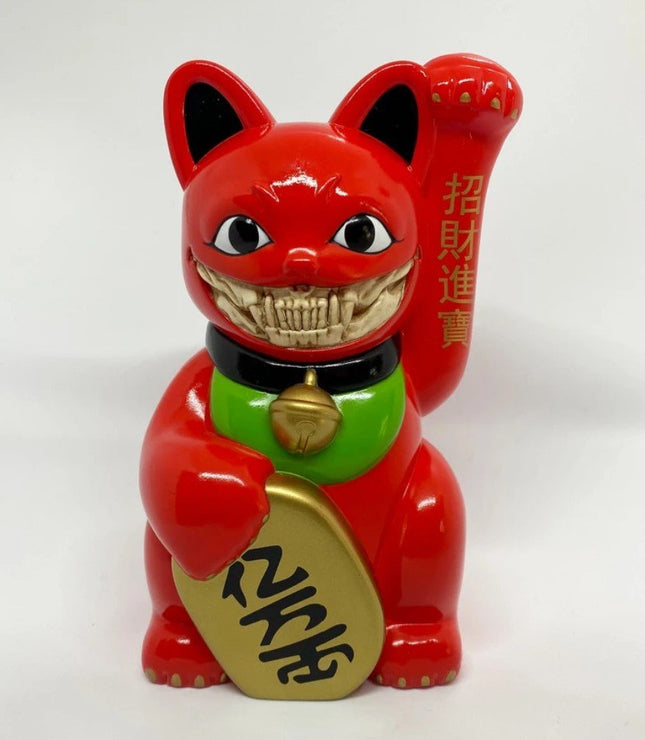
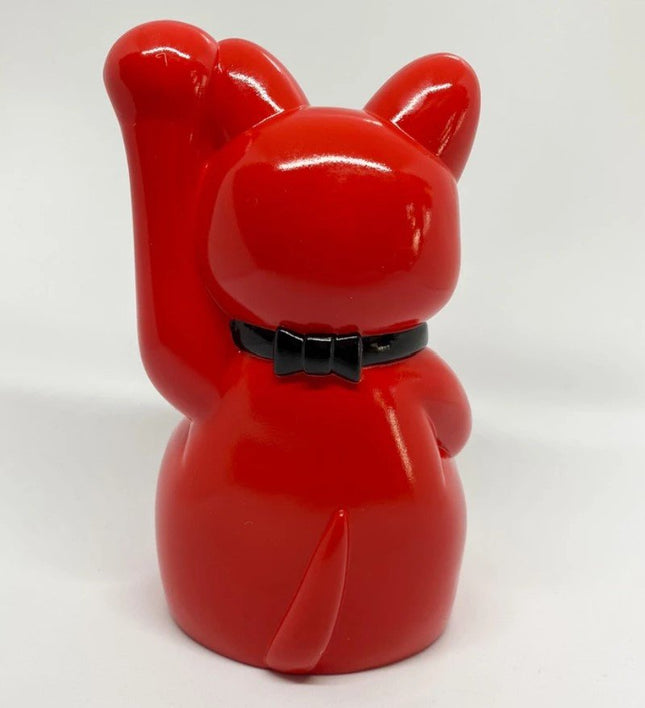
Ron English Lucky Cat Grin Convention Red Art Toy Sculpture by Ron English
Lucky Cat Grin- Convention Red Limited Edition Vinyl Art Toy Collectible Artwork by Artist Ron English Contemporary Pop Artwork. 2018 Signed Limited Edition New In Box SFBI x Ron English presents Lucky Cat Grin.6 inches tall. Hand-signed by Ron English, 2018 SDCC Exclusive
$364.00
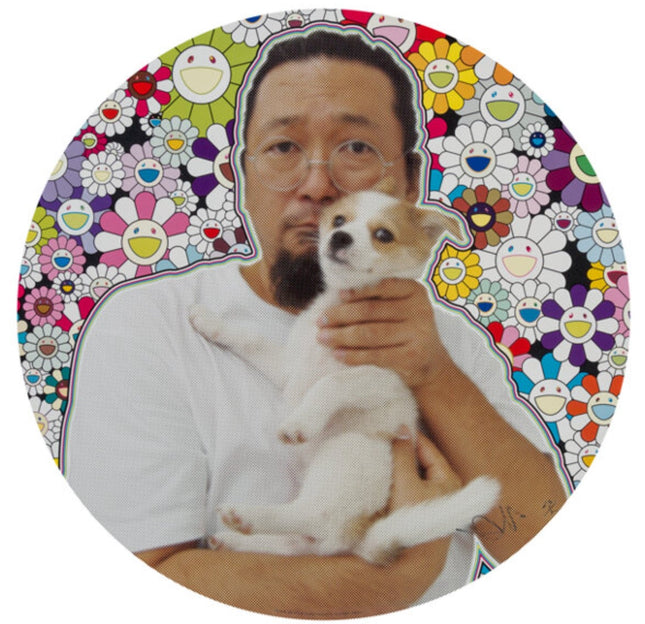
Takashi Murakami TM/KK POM & Me Lithograph Print by Takashi Murakami TM/KK
POM & Me Offset Lithograph Print Limited Edition Artwork on Round Smooth Wove Paper by Pop Urban Artist Takashi Murakami TM/KK. 2013 Signed & Numbered Limited Edition of 300 Round Cut Artwork Size 19.75x19.75 (Round) Takashi Murakami (b. 1962) POM & Me, 2013 Offset lithograph in colors on smooth wove paper 19-5/8 inches (49.8 cm) diameter (sheet) Ed. 300 Signed and numbered in ink lower right Published by Kaikai Kiki Co. Ltd., Tokyo "POM & Me" is a lithograph print by the renowned Japanese artist Takashi Murakami. Known for his unique style that blends traditional Japanese art with contemporary pop culture, Murakami has gained international acclaim for his work. His signature "Superflat" style is characterized by bold, vibrant colors and flattened, two-dimensional imagery. The "POM & Me" print is one of many artworks that Murakami has created over the years, often featuring his iconic characters and motifs. This particular piece includes recurring elements from Murakami's body of work, such as his famous flowers, himself and his dog Pom. As an artist, Murakami has worked in various media, from painting and sculpture to fashion and commercial products. His work has been exhibited in major galleries and museums worldwide, and he has collaborated with well-known brands and celebrities.
$2,706.00
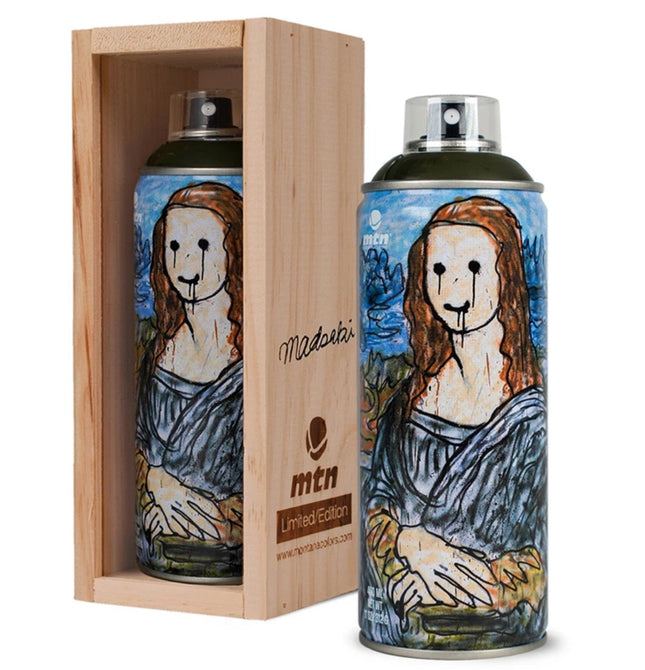
Madsaki Madsaki Mona Lisa 3 Dharma Green Spray Paint Can Artwork by Montana MTN
Madsaki- Mona Lisa 3 Dharma Green Limited Edition Rare Spray Paint Can Artwork Crossover by famous graffiti paint maker Montana MTN. Mona Lisa 3 Spray Paint Can, 2021 MNT Colors Spray Paint, Low Pressure Can in Wood and Acrylic Case Spray Paint Color: Dharma Green 400ml. Limited Edition of 500 MADSAKI immortalizes one icon with another, remaking the Mona Lisa with Montana Colors paint brand. Born in Osaka in 1974, and relocated to New Jersey at a young age, MADSAKI graduated from the Parsons School of Design in New York (BFA, 1996) and was a member of international artist group Barnstormers before starting his solo career. Both satirical and sentimental, aggressive yet vulnerable, MADSAKI has used graffiti influences as a way to express the frustration and alienation of his bicultural identity and to critique the value of art.
$242.00
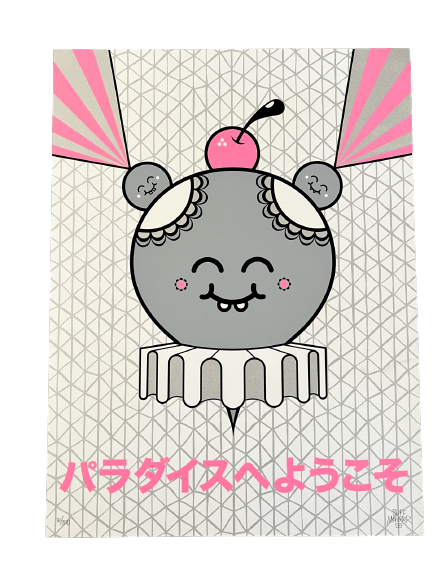
Buff Monster Welcome To Paradise Silkscreen Print by Buff Monster
Welcome To Paradise Silkscreen Print by Buff Monster Hand-Pulled on Fine Art Paper Limited Edition Artwork. 2008 Signed & Numbered Limited Edition of 100 Artwork Size 18x24 Silkscreen Print The "Welcome to Paradise" silkscreen print by Buff Monster stands as a vibrant example of Street Pop Art and Graffiti Artwork, blending street art's energy with pop art's playful vibrancy. Created in 2008, this piece is part of a limited edition series, with only 100 signed and numbered prints available, making it a collectible item among enthusiasts. The artwork measures 18x24 inches, a size that is substantial enough to impact any wall it adorns. Buff Monster has been a notable figure in the street art scene, with his work often characterized by bright colors, bold lines, and whimsical characters, all evident in this print. His signature style often incorporates influences from various sources, including Japanese culture and classic graffiti art. This has earned him a dedicated following and places his work in a unique position within contemporary art. Hand-pulling silkscreen prints are traditional and meticulous, ensuring each piece is unique with slight variations that add to its character and authenticity. This print on fine art paper captures the essence of Buff Monster's artistic vision, with its meticulously layered colors and textures providing depth and a tactile quality that machine-made reproductions cannot replicate. As a work of Street Pop Art and Graffiti Artwork, "Welcome to Paradise" embodies the spirit of urban creativity and the blurring of boundaries between high and low art. It is a testament to the artist's ability to translate the spontaneity and rebelliousness of street art into a fine art context, preserving the raw appeal of graffiti while elevating it through a more formalized art-making process. For collectors and enthusiasts, acquiring a piece like this offers a visual delight and a slice of the dynamic and ever-evolving story of street art's influence on contemporary culture.
$500.00
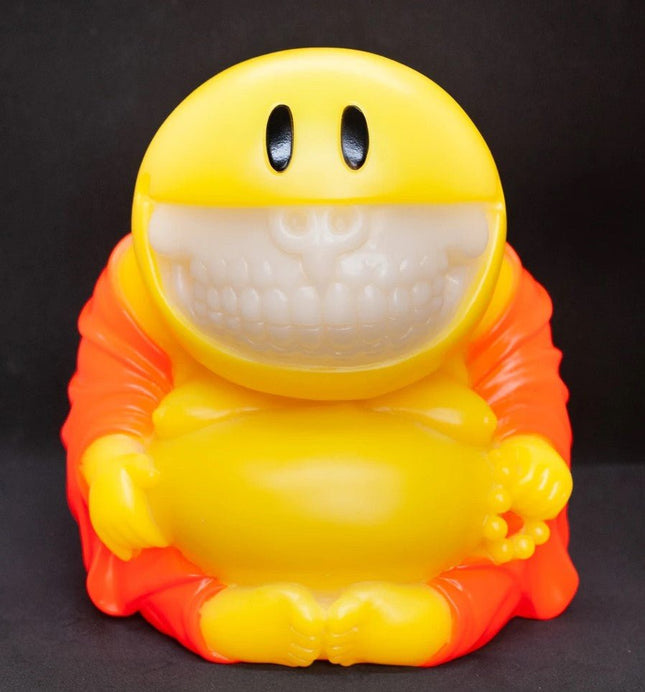
Ron English Mad Happy Monk Grin Orange Art Toy by Ron English
Mad Happy Monk Grin- Orange Limited Edition Blacklight Vinyl Art Toy Collectible Artwork by Street Graffiti Artist Ron English. 2019 Signed Limited Edition New In Box. Blacklight orange colorway of the Mad Happy Monk is 8 inches tall. Hand-signed by Ron
$242.00
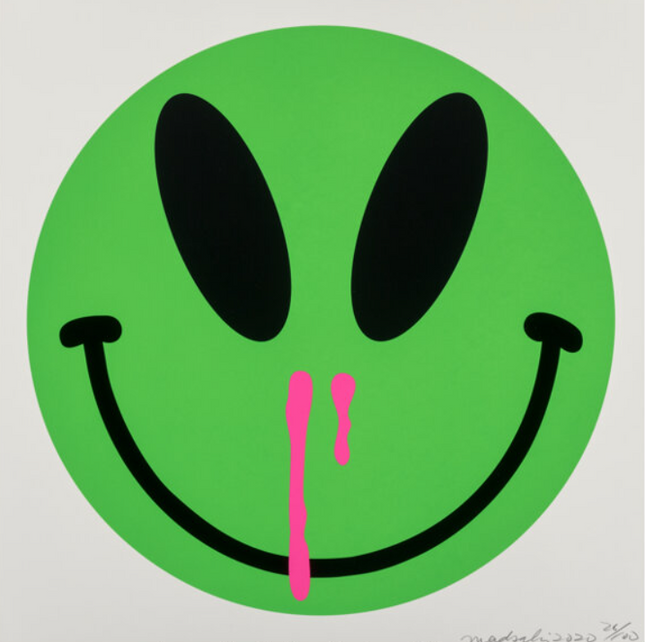
Madsaki Cosmic Overdose_P Offset Lithograph Print by Madsaki
Happiness Overdose Azul Mariano_P Offset Lithograph Print by Madsaki Print on Wove Fine Art Paper Limited Edition Hand-Pulled Street Pop Artwork Graffiti. 2020 Signed & Numbered Limited Edition of 100 Offset Lithograph Artwork Print Size 19.75x19.75 Smiley Face With Bloody Nose in Blue. Kaikai Kiki Co. Ltd, Tokyo. Unconventional Aesthetics of Madsaki's Artwork Madsaki's artwork, characterized by its distinctive use of color and form, critiques modern society's obsession with happiness and the often ironic underpinnings of this pursuit. The "Happiness Overdose Azul Mariano_P" print showcases a smiley face—a universally recognized symbol of joy—juxtaposed with a bloody nose, suggesting an overdose of happiness to the point of harm. This striking imagery, rendered in bold blue on fine art paper, invites viewers to question the true nature of joy and the cost of its excess. The resurgence of pop art in the contemporary art scene is epitomized by the creative convergence of street art and graffiti, with artists like Madsaki at the forefront. "Happiness Overdose Azul Mariano_P," a limited edition offset lithograph print by Madsaki, exemplifies this trend, blending the rebellious spirit of street art with the vibrant aesthetics of pop art. Madsaki's artwork, characterized by its distinctive use of color and form, critiques modern society's obsession with happiness and the often ironic underpinnings of this pursuit. The "Happiness Overdose Azul Mariano_P" print showcases a smiley face—a universally recognized symbol of joy—juxtaposed with a bloody nose, suggesting an overdose of happiness to the point of harm. This striking imagery, rendered in bold blue on fine art paper, invites viewers to question the true nature of joy and the cost of its excess. The Cultural Significance of Offset Lithograph Prints Offset lithography, a common technique for fine art reproduction, allows artists like Madsaki to reach a wider audience by creating multiple copies of original works. This print's size of 19.75x19.75 inches is substantial yet accessible, fitting the urban environments that often inspire street pop art. Hand-pulling each print ensures that every piece retains a touch of the artist's hand despite being part of a limited edition series. The choice of woven fine art paper as the medium further signifies a blend of street art's immediacy and fine art's enduring quality. In the context of street pop culture, limited edition artworks such as "Happiness Overdose Azul Mariano_P" reflect the exclusivity and collectibility that street art has gained in the art market. The limited edition of 100 pieces, each signed and numbered by Madsaki, speaks to the artist's personalized connection with his work and collectors. It represents a shift from the transient nature of traditional graffiti to a more permanent, revered form of artistic expression. Integration of Street Art into Mainstream Art Galleries Madsaki's collaboration with Kaikai Kiki Co. Ltd, Tokyo, a company known for its role in promoting contemporary artists, underscores the increasing integration of street pop art into mainstream art galleries and the broader art world. This partnership illustrates the potential for street-inspired artworks to be celebrated alongside more traditional acceptable art forms, signaling a shift in cultural perceptions and the breaking down of barriers between high art and popular culture. The impact of "Happiness Overdose Azul Mariano_P" extends beyond its visual composition; it encapsulates the evolution of street art into a form that is both a critical commentary on society and a coveted acceptable art commodity. Through his work, Madsaki challenges viewers to reassess their understanding of happiness, consumerism, and the role of art in modern culture. His street pop art & graffiti artwork continue to resonate with audiences around the globe, bridging the gap between underground art movements and the polished white walls of galleries.
$2,500.00
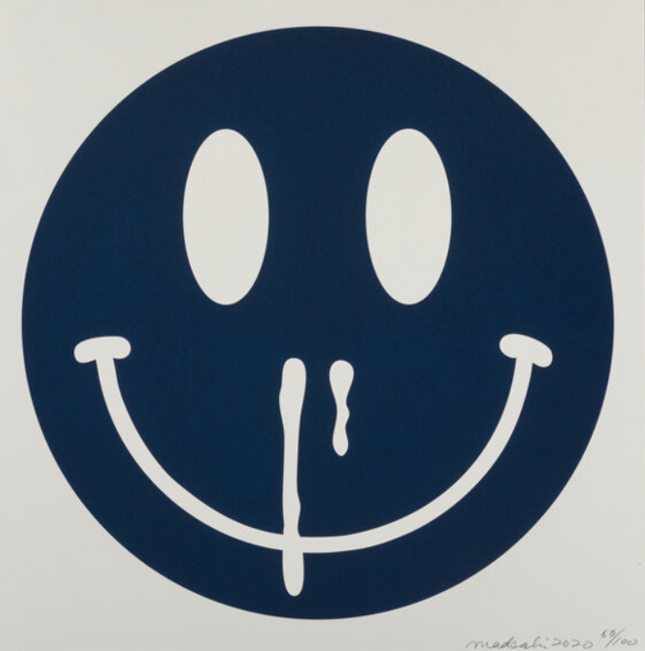
Madsaki Happiness Overdose Azul Mariano_P Offset Lithograph Print by Madsaki
Happiness Overdose Azul Mariano_P Offset Lithograph Print by Madsaki Print on Wove Fine Art Paper Limited Edition Hand-Pulled Street Pop Artwork Graffiti. 2020 Signed & Numbered Limited Edition of 100 Offset Lithograph Artwork Print Size 19.75x19.75 Smiley Face With Bloody Nose in Blue. Kaikai Kiki Co. Ltd, Tokyo. Blending Iconography with Contemporary Critique "Happiness Overdose Azul Mariano_P" is a captivating example of Madsaki's work, exemplifying the essence of Street Pop Art and graffiti Artwork through its graphic simplicity and poignant symbolism. This 2020 offset lithograph print on wove fine art paper, signed and numbered as a limited edition of only 100, showcases a unique blend of street art's rawness with the mass appeal of pop art. The artwork, measuring 19.75x19.75 inches, presents a stylized smiley face with a blue hue and a notable addition: a bloody nose. This visual twist plays with the universally recognized symbol of happiness, the smiley face, subverting it to convey a more profound, more complex message. Madsaki's choice to depict the smiley with a bloody nose might be interpreted as a commentary on the excesses of contemporary society, where the pursuit of happiness can sometimes lead to self-destructive behaviors. The use of a singular bold color, Azul Mariano, lends the piece a striking visual presence, with the blue acting as both a backdrop and a critical element of the artwork. The color choice may invoke various emotional responses, from calmness to melancholy, further enriching the artwork's interpretive layers. Artistic Expression in Street Pop Art & Graffiti Artwork Madsaki's "Happiness Overdose Azul Mariano_P" is a testament to the power of Street Pop Art and graffiti Artwork to communicate complex ideas through seemingly simple imagery. The expressive capacity of the work is amplified by its minimalist approach, where the absence of intricate details forces the viewer to confront the unsettling juxtaposition of the smiley's cheerful connotations with the graphic indication of distress. As with much of Street Pop Art and graffiti Artwork, there's an inherent accessibility in Madsaki's lithograph. The smiley face, a pervasive icon of modern digital communication, becomes a canvas for social commentary, allowing the artwork to resonate with a diverse audience. The limited-edition nature of "Happiness Overdose Azul Mariano_P" elevates it from a piece of street art to a sought-after collectible, bridging the gap between graffiti's ephemeral nature and fine art's permanence. In conclusion, the piece serves as a work of art and a cultural critique, encapsulating the dualities in pursuing happiness in the modern age. The choice to produce a limited run of prints ensures that each piece remains a unique and valuable addition to contemporary art discourse. Madsaki's "Happiness Overdose Azul Mariano_P" stands as a compelling intersection of pop iconography and street art sensibility, a visual exploration of the highs and lows of the human condition.
$2,500.00











